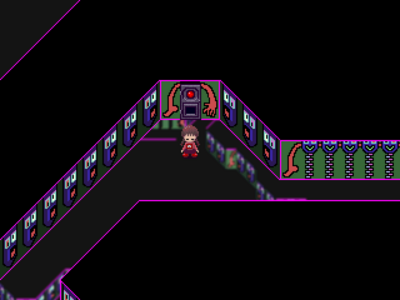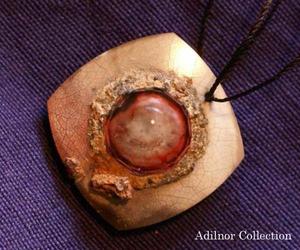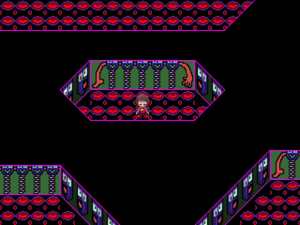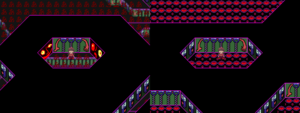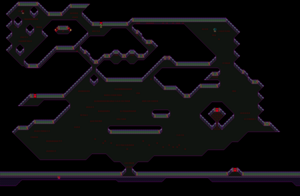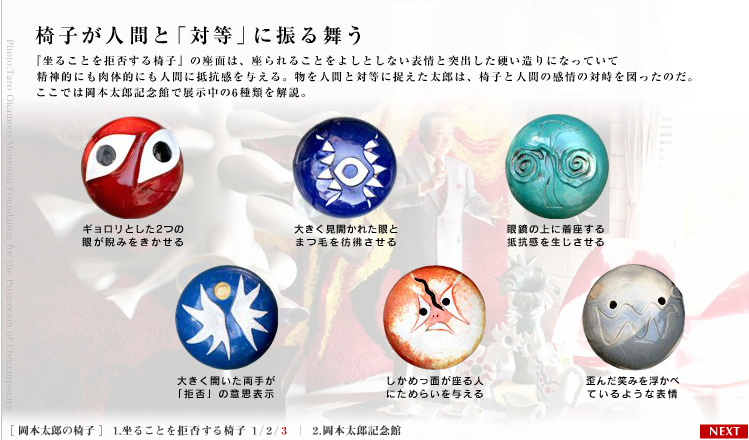>Mt.kiki No edit summary |
No edit summary |
||
| (23 intermediate revisions by 6 users not shown) | |||
| Line 1: | Line 1: | ||
[[File: | [[File:YN Number World.png|thumb|400px|link=http://yumenikki.wikia.com/wiki/Number_World|left|Number World(Red Evil Eye Door)]] | ||
| Line 40: | Line 40: | ||
<u>[[File:Ruby_Eye_Pendant.jpg|thumb|]][http://en.wikipedia.org/wiki/Evil_eye#Protective_talismans_and_cures 4 Protective talismans and cures]</u> | <u>[[File:Ruby_Eye_Pendant.jpg|thumb|]][http://en.wikipedia.org/wiki/Evil_eye#Protective_talismans_and_cures 4 Protective talismans and cures]</u> | ||
A Ruby Eye Pendant from an ancient civilization in Mesopotamia was possibly used as amulet to protect against evil eyes. Adilnor Collection. | A Ruby Eye Pendant from an ancient civilization in Mesopotamia was possibly used as amulet to protect against evil eyes. Adilnor Collection. | ||
==[http://ja.wikipedia.org/wiki/%E9%9A%BB%E7%9C%BC#.E8.B5.B7.E6.BA.90 The Evil Eye] Door([http://ja.wikipedia.org/wiki/%E9%9A%BB%E7%9C%BC 隻眼])== | ==[http://ja.wikipedia.org/wiki/%E9%9A%BB%E7%9C%BC#.E8.B5.B7.E6.BA.90 The Evil Eye] Door([http://ja.wikipedia.org/wiki/%E9%9A%BB%E7%9C%BC 隻眼])== | ||
[http://ja.wikipedia.org/wiki/%E9%9A%BB%E7%9C%BC#.E7.A5.9E.E8.A9.B1.E3.83.BB.E4.BC.9D.E8.AA.AC.E3.81.AE.E4.B8.AD.E3.81.AE.E9.9A.BB.E7.9C.BC <u>3 神話・伝説の中の隻眼</u>] (3 One-eye in the legend, myth) | [http://ja.wikipedia.org/wiki/%E9%9A%BB%E7%9C%BC#.E7.A5.9E.E8.A9.B1.E3.83.BB.E4.BC.9D.E8.AA.AC.E3.81.AE.E4.B8.AD.E3.81.AE.E9.9A.BB.E7.9C.BC <u>3 神話・伝説の中の隻眼</u>] (3 One-eye in the legend, myth) | ||
| Line 49: | Line 47: | ||
[http://ja.wikipedia.org/wiki/%E9%9A%BB%E7%9C%BC 隻眼](seki-gan) or 独眼(doku-gan) is, refers to a state of disability that has lost sight of the eye itself and one side. | [http://ja.wikipedia.org/wiki/%E9%9A%BB%E7%9C%BC 隻眼](seki-gan) or 独眼(doku-gan) is, refers to a state of disability that has lost sight of the eye itself and one side. | ||
---- | |||
[http://ja.wikipedia.org/wiki/%E9%9A%BB%E7%9C%BC#.E5.BD.A2.E6.85.8B <u>3.1 形態</u>](3.1 Form) | [http://ja.wikipedia.org/wiki/%E9%9A%BB%E7%9C%BC#.E5.BD.A2.E6.85.8B <u>3.1 形態</u>](3.1 Form) | ||
| Line 58: | Line 60: | ||
Sekigan, which is a shape asymmetrical non-existent one of the eye should be two original is lost or is literally (as in [http://en.wikipedia.org/wiki/Cyclopia cyclopia]) in some one in the middle of the face eyes may be expressed only exists (such as [http://en.wikipedia.org/wiki/Cyclops Cyclops]). | Sekigan, which is a shape asymmetrical non-existent one of the eye should be two original is lost or is literally (as in [http://en.wikipedia.org/wiki/Cyclopia cyclopia]) in some one in the middle of the face eyes may be expressed only exists (such as [http://en.wikipedia.org/wiki/Cyclops Cyclops]). | ||
[http://yumenikki.wikia.com/wiki/Ghost_World#Points_of_Interest 1 Points of Interest] | [http://yumenikki.wikia.com/wiki/Ghost_World#Points_of_Interest 1 Points of Interest] | ||
| Line 66: | Line 66: | ||
---- | ---- | ||
[http://ja.wikipedia.org/wiki/%E9%9A%BB%E7%9C%BC#.E8.B5.B7.E6.BA.90 <u>3.3 起源</u>] (3.3 Origin) | [http://ja.wikipedia.org/wiki/%E9%9A%BB%E7%9C%BC#.E8.B5.B7.E6.BA.90 <u>3.3 起源</u>] (3.3 Origin) | ||
| Line 76: | Line 73: | ||
[http://yumenikki.wikia.com/wiki/Number_World(name)#The_Evil_Eye_Door.28Evil_eye.29 1 The Evil Eye Door(Evil eye)] | |||
A Ruby Eye Pendant from an ancient civilization in Mesopotamia was possibly used as amulet to protect against evil eyes. | |||
---- | |||
[http://ja.wikipedia.org/wiki/%E9%9A%BB%E7%9C%BC#.E8.B5.B7.E6.BA.90 <u>3.3 起源</u>] (3.3 Origin) | |||
北欧神話が所属する[http://ja.wikipedia.org/wiki/%E3%82%A4%E3%83%B3%E3%83%89%E3%83%BB%E3%83%A8%E3%83%BC%E3%83%AD%E3%83%83%E3%83%91%E8%AA%9E%E6%97%8F <u>インド・ヨーロッパ語族</u>]の伝承については、[http://ja.wikipedia.org/wiki/%E3%82%B8%E3%83%A7%E3%83%AB%E3%82%B8%E3%83%A5%E3%83%BB%E3%83%87%E3%83%A5%E3%83%A1%E3%82%B8%E3%83%AB <u>ジョルジュ・デュメジル</u>]が彼の三機能仮説における第一機能との関連を主張した。明確な理由は不明だが、第一機能(呪術的主権・司法的主権の二項対立がある)のうち一方は片目がなく、もう一方は片腕がない、というものである。 | 北欧神話が所属する[http://ja.wikipedia.org/wiki/%E3%82%A4%E3%83%B3%E3%83%89%E3%83%BB%E3%83%A8%E3%83%BC%E3%83%AD%E3%83%83%E3%83%91%E8%AA%9E%E6%97%8F <u>インド・ヨーロッパ語族</u>]の伝承については、[http://ja.wikipedia.org/wiki/%E3%82%B8%E3%83%A7%E3%83%AB%E3%82%B8%E3%83%A5%E3%83%BB%E3%83%87%E3%83%A5%E3%83%A1%E3%82%B8%E3%83%AB <u>ジョルジュ・デュメジル</u>]が彼の三機能仮説における第一機能との関連を主張した。明確な理由は不明だが、第一機能(呪術的主権・司法的主権の二項対立がある)のうち一方は片目がなく、もう一方は片腕がない、というものである。 | ||
For Indo-European tradition that belongs to Norse mythology, Georges Dumezil has claimed the first function in the context of his three feature hypothesis. Obvious reason is unknown, but is one of those (there is a dichotomy of sovereignty and judicial sovereignty magical) function does not have a first one eye, one that there is no other arm. | For Indo-European tradition that belongs to Norse mythology, Georges Dumezil has claimed the first function in the context of his three feature hypothesis. Obvious reason is unknown, but is one of those (there is a dichotomy of sovereignty and judicial sovereignty magical) function does not have a first one eye, one that there is no other arm. | ||
[http://yumenikki.wikia.com/wiki/Number_World(name)#Number_World.28Magic_number_.28programming.29.29 5 Number World(Magic number (programming))] | |||
there is a dichotomy of sovereignty and judicial sovereignty magical([http://ja.wikipedia.org/wiki/%E9%9A%BB%E7%9C%BC 隻眼])→[http://en.wikipedia.org/wiki/Magic_number_(programming) Magic number (programming)]? | |||
---- | ---- | ||
[http://ja.wikipedia.org/wiki/%E9%9A%BB%E7%9C%BC#.E8.B5.B7.E6.BA.90 <u>3.3 起源</u>] (3.3 Origin) | |||
つまり隻腕ならびに一本足が、この場合では隻眼、隻腕の組み合わせになっている。たとえばオーディンは片目がないが、[http://ja.wikipedia.org/wiki/%E3%83%86%E3%83%A5%E3%83%BC%E3%83%AB <u>テュール</u>]は片腕がない([http://ja.wikipedia.org/wiki/%E3%83%95%E3%82%A7%E3%83%B3%E3%83%AA%E3%83%AB <u>フェンリル</u>]狼に食いちぎられた)。 | つまり隻腕ならびに一本足が、この場合では隻眼、隻腕の組み合わせになっている。たとえばオーディンは片目がないが、[http://ja.wikipedia.org/wiki/%E3%83%86%E3%83%A5%E3%83%BC%E3%83%AB <u>テュール</u>]は片腕がない([http://ja.wikipedia.org/wiki/%E3%83%95%E3%82%A7%E3%83%B3%E3%83%AA%E3%83%AB <u>フェンリル</u>]狼に食いちぎられた)。 | ||
[[File:Kyukyu.png|thumb|KyuuKyuu-kun(Tyr)]] | |||
One leg, but in this case is a combination Sekigan, namely the one-armed and one-armed. Odin has one eye is not, for example, is [http://en.wikipedia.org/wiki/T%C3%BDr Týr] (which was bitten off by the wolf Fenrir) there is no arm. | One leg, but in this case is a combination Sekigan, namely the one-armed and one-armed. Odin has one eye is not, for example, is [http://en.wikipedia.org/wiki/T%C3%BDr Týr] (which was bitten off by the wolf Fenrir) there is no arm. | ||
[http://yumenikki.wikia.com/wiki/KyuuKyuu-kun(name)#KyuuKyuu-kun.28T.C3.BDr.29 3 KyuuKyuu-kun(Týr)] | [http://yumenikki.wikia.com/wiki/KyuuKyuu-kun(name)#KyuuKyuu-kun.28T.C3.BDr.29 3 KyuuKyuu-kun(Týr)] | ||
[http://yumenikki.wikia.com/wiki/KyuuKyuu-kun KyuuKyuu-kun](some loss of arm strength?) and [http://yumenikki.wikia.com/wiki/Number_World Number World] Door is only Right arm. | [http://yumenikki.wikia.com/wiki/KyuuKyuu-kun KyuuKyuu-kun](some loss of arm strength?) and [http://yumenikki.wikia.com/wiki/Number_World Number World] Door is only Right arm. | ||
==[[Yume Nikki:Effects#Crick in the Neck|Crick in the Neck]]([http://ja.wikipedia.org/wiki/%E9%9A%BB%E7%9C%BC 隻眼])== | |||
[http://ja.wikipedia.org/wiki/%E9%9A%BB%E7%9C%BC#.E8.B5.B7.E6.BA.90 <u>3.3 起源</u>](3.3 Origin) | |||
[[File:AAAA_Lampworld.png|thumb|Crick in the Neck(隻眼)]] | |||
学術的な観点からもいくつかの説が唱えられている。日本だけに限れば、[http://ja.wikipedia.org/wiki/%E6%9F%B3%E7%94%B0%E5%9C%8B%E7%94%B7 <u>柳田國男</u>]は、Several theories have been cast from an academic point of view. Be limited to Japan, "[http://en.wikipedia.org/wiki/Kunio_Yanagita Kunio Yanagida]", | |||
[[File:Looking_Left.png|thumb|"Madotsuki" is a one-eyed look from the front.]] | |||
もともと神に捧げるべき生け贄の人間が逃亡しないように片目(と片脚)を傷つけていたのが神格と同一視されるようになったのが原因であると考えた(『[http://ja.wikipedia.org/wiki/%E4%B8%80%E3%81%A4%E7%9B%AE%E5%B0%8F%E5%83%A7 <u>一つ目小僧</u>]その他』)。 | |||
the cause had been hurt in one eye (one leg) and have that came to be identified with the deity of human sacrifice to be dedicated to God originally to prevent the escape it was considered to be (and so "[http://en.wikipedia.org/wiki/Hitotsume-koz%C5%8D one-eyed boys]") | |||
---- | |||
[http://yumenikki.wikia.com/wiki/Events#Gameplay_Events 1 Gameplay Events] | |||
*[http://yumenikki.wikia.com/wiki/Events#Crick_in_the_Neck 1.2 Crick in the Neck] | |||
<p class="toclevel-2 tocsection-3">Description: Occasionally, when Madotsuki gets out of bed she will have a 'crick' in her neck, causing her head to be constantly turned to the left.</p> | |||
※"[[Yume Nikki:Madotsuki|Madotsuki]]" is a one-eyed([http://ja.wikipedia.org/wiki/%E9%9A%BB%E7%9C%BC 隻眼]?) look from the front. | |||
==Chuck Man([http://ja.wikipedia.org/wiki/%E9%9A%BB%E7%9C%BC 隻眼])== | ==Chuck Man([http://ja.wikipedia.org/wiki/%E9%9A%BB%E7%9C%BC 隻眼])== | ||
[[File:Chuck_Man(Odd_Eye).jpg|thumb|Chuck_Man(Odd_Eye)]][http://ja.wikipedia.org/wiki/%E9%9A%BB%E7%9C%BC#.E8.B5.B7.E6.BA.90 <u>3.3 起源</u>](3.3 Origin) | [[File:Chuck_Man(Odd_Eye).jpg|thumb|Chuck_Man(Odd_Eye)]][http://ja.wikipedia.org/wiki/%E9%9A%BB%E7%9C%BC#.E8.B5.B7.E6.BA.90 <u>3.3 起源</u>](3.3 Origin) | ||
| Line 97: | Line 127: | ||
In addition to the theory (such as Wet and Dry Alan Dandesu folklorist, "Study of the mountain god" Yoshio Hotta and the Evil Eye) theory that is a symbol of phallic, and is a symbol of the sun Sekigan Arthur classical scholar (hypothesis, and much more) and that his followers Zeusvol.2 Bernard Cook exists but is not critical either. | In addition to the theory (such as Wet and Dry Alan Dandesu folklorist, "Study of the mountain god" Yoshio Hotta and the Evil Eye) theory that is a symbol of phallic, and is a symbol of the sun Sekigan Arthur classical scholar (hypothesis, and much more) and that his followers Zeusvol.2 Bernard Cook exists but is not critical either. | ||
==Chuck Man([http://en.wikipedia.org/wiki/Zipper Zipper])== | |||
[ | A '''zipper''', '''zip''', or '''zip fastener''', is a commonly used device for binding the edges of an opening of [http://en.wikipedia.org/wiki/Textile <u>fabric</u>] or other flexible material, as on a garment or a bag.<sup class="reference" id="cite_ref-1">[http://en.wikipedia.org/wiki/Zipper#cite_note-1 <u>[1</u>]]</sup> | ||
Zippers may | |||
*increase or decrease the size of an opening to allow or restrict the passage of objects, as in the fly of [http://en.wikipedia.org/wiki/Trousers <u>trousers</u>] or in a [http://en.wikipedia.org/wiki/Pocket <u>pocket</u>]. | |||
[ | [[File:450px-Plastic-_and_Nylonzipper.jpg|thumb|100px|Chuck Man(Zipper)]] | ||
---- | |||
[ | [http://yumenikki.wikia.com/wiki/Number_World(name)#Chuck_Man.28.E9.9A.BB.E7.9C.BC.29 4 Chuck Man(隻眼)] | ||
In addition to the theory (such as Wet and Dry Alan Dandesu folklorist, "Study of the mountain god" Yoshio Hotta and the Evil Eye) theory that is a symbol of phallic. | |||
※Chuck Man is A man wearing trousers→theory that is a symbol of phallic([http://ja.wikipedia.org/wiki/%E9%9A%BB%E7%9C%BC 隻眼]) | |||
==[[Number World]]([https://ja.wikipedia.org/wiki/%E5%8B%87%E8%80%85 勇者])== | ==[[Yume Nikki:Number World|Number World]]([https://ja.wikipedia.org/wiki/%E5%8B%87%E8%80%85 勇者])== | ||
[[File:AAAAA_Trap.png|thumb|Number World(ああああ)]] | [[File:AAAAA_Trap.png|thumb|Number World(ああああ)]] | ||
[https://ja.wikipedia.org/wiki/%E5%8B%87%E8%80%85#.E3.83.95.E3.82.A1.E3.83.B3.E3.82.BF.E3.82.B8.E3.83.BC.E3.81.AB.E3.81.8A.E3.81.91.E3.82.8B.E5.8B.87.E8.80.85 <u>3 ファンタジーにおける勇者</u>] | [https://ja.wikipedia.org/wiki/%E5%8B%87%E8%80%85#.E3.83.95.E3.82.A1.E3.83.B3.E3.82.BF.E3.82.B8.E3.83.BC.E3.81.AB.E3.81.8A.E3.81.91.E3.82.8B.E5.8B.87.E8.80.85 <u>3 ファンタジーにおける勇者</u>] | ||
*[https://ja.wikipedia.org/wiki/%E5%8B%87%E8%80%85#.E3.82.B3.E3.83.B3.E3.83.94.E3.83.A5.E3.83.BC.E3.82.BF.E3.82.B2.E3.83.BC.E3.83.A0.E3.81.A8.E3.83.91.E3.83.AD.E3.83.87.E3.82.A3 <u>3.1 コンピュータゲームとパロディ</u>] | *[https://ja.wikipedia.org/wiki/%E5%8B%87%E8%80%85#.E3.82.B3.E3.83.B3.E3.83.94.E3.83.A5.E3.83.BC.E3.82.BF.E3.82.B2.E3.83.BC.E3.83.A0.E3.81.A8.E3.83.91.E3.83.AD.E3.83.87.E3.82.A3 <u>3.1 コンピュータゲームとパロディ</u>] | ||
コンピューターゲームにおいては主人公の名前などをプレイヤー自身で設定できるようになっているものも多い反面、適当に命名するプレイヤーもそれなりにおり、名前入力画面でカーソルの初期設定位置にある「あ」を連続で入力した「ああああ」という名前がコンピューターゲームの勇者の名前としてパロディ・オマージュ的に引き合いに出されることがある(『魔法陣グルグル』『[https://ja.wikipedia.org/wiki/%E5%8B%87%E8%80%85%E3%81%AE%E3%81%8F%E3%81%9B%E3%81%AB%E3%81%AA%E3%81%BE%E3%81%84%E3%81%8D%E3%81%A0%E3%80%82 <u>勇者のくせになまいきだ。</u>]』など)。 | コンピューターゲームにおいては主人公の名前などをプレイヤー自身で設定できるようになっているものも多い反面、適当に命名するプレイヤーもそれなりにおり、名前入力画面でカーソルの初期設定位置にある「あ」を連続で入力した「ああああ」という名前がコンピューターゲームの勇者の名前としてパロディ・オマージュ的に引き合いに出されることがある(『魔法陣グルグル』『[https://ja.wikipedia.org/wiki/%E5%8B%87%E8%80%85%E3%81%AE%E3%81%8F%E3%81%9B%E3%81%AB%E3%81%AA%E3%81%BE%E3%81%84%E3%81%8D%E3%81%A0%E3%80%82 <u>勇者のくせになまいきだ。</u>]』など)。 | ||
While there is much what can set up a hero's name etc. now for player itself in a computer game, The name which inputted continuously "あ" where the player named suitably is also as it is, and which has it in the initial setting position of a cursor on a name input screen may be referred to in parody hommage as a name of a computer game. | |||
==Number World([http://en.wikipedia.org/wiki/Magic_number_(programming) Magic number (programming)])== | |||
== | |||
In [http://en.wikipedia.org/wiki/Computer_programming <u>computer programming</u>], the term '''magic number''' has multiple meanings. | In [http://en.wikipedia.org/wiki/Computer_programming <u>computer programming</u>], the term '''magic number''' has multiple meanings. | ||
| Line 144: | Line 175: | ||
Updated: 2013/02/18<br />"ゆめにっき Yume Nikki 06 Famicom World" #0:30~0:55 | |||
Movie by marqueskart | |||
http://www.youtube.com/watch?v=eCWf8kbrg6k | |||
==Number World([http://en.wikipedia.org/wiki/Binary_number Binary number])== | |||
== | |||
[[File:Number_World(Binary_number).png|thumb|Number World(Binary number)]] | [[File:Number_World(Binary_number).png|thumb|Number World(Binary number)]] | ||
In [http://en.wikipedia.org/wiki/Mathematics <u>mathematics</u>] and [http://en.wikipedia.org/wiki/Computer_science <u>computer science</u>], the '''binary numeral system''', or '''base-2 numeral system''', represents numeric values using two symbols: typically [http://en.wikipedia.org/wiki/0_(number) <u>0</u>] and [http://en.wikipedia.org/wiki/1_(number) <u>1</u>]. | In [http://en.wikipedia.org/wiki/Mathematics <u>mathematics</u>] and [http://en.wikipedia.org/wiki/Computer_science <u>computer science</u>], the '''binary numeral system''', or '''base-2 numeral system''', represents numeric values using two symbols: typically [http://en.wikipedia.org/wiki/0_(number) <u>0</u>] and [http://en.wikipedia.org/wiki/1_(number) <u>1</u>]. | ||
[http://en.wikipedia.org/wiki/Binary_number#History <u>1 History</u>] | [http://en.wikipedia.org/wiki/Binary_number#History <u>1 History</u>] | ||
| Line 172: | Line 195: | ||
[http://yumenikki.wikia.com/wiki/Windmill_World(name)#Windmill_World.28THE_MONADOLOGY.29 1 Windmill World(THE MONADOLOGY)] | [http://yumenikki.wikia.com/wiki/Windmill_World(name)#Windmill_World.28THE_MONADOLOGY.29 1 Windmill World(THE MONADOLOGY)] | ||
In imagining that there is a machine whose construction would enable it to think, to sense, and to have perception, one could conceive it enlarged while retaining the same proportions, so that one could enter into it, just like into a windmill. | |||
The thought experiment of the windmill by [http://en.wikipedia.org/wiki/Gottfried_Wilhelm_Leibniz Leibniz] | The thought experiment of the windmill by [http://en.wikipedia.org/wiki/Gottfried_Wilhelm_Leibniz Leibniz] | ||
| Line 183: | Line 208: | ||
by [http://en.wikipedia.org/wiki/Gottfried_Wilhelm_Leibniz Goottfried Wilhelm Leibniz ]translated by [http://www.rbjones.com/rbjpub/philos/classics/leibniz/monad.htm Robert Latta] | by [http://en.wikipedia.org/wiki/Gottfried_Wilhelm_Leibniz Goottfried Wilhelm Leibniz ]translated by [http://www.rbjones.com/rbjpub/philos/classics/leibniz/monad.htm Robert Latta] | ||
==[[Yume Nikki:Wheelies|Wheelies(Number World)]]([http://en.wikipedia.org/wiki/Tar%C5%8D_Okamoto Tarō Okamoto])== | |||
==[[ | |||
Tarō Okamoto <span style="font-weight: normal;">(岡本 太郎<span class="t_nihongo_comma" style="display: none;">,</span> ''Okamoto Tarō''<sup>[http://en.wikipedia.org/wiki/Help:Installing_Japanese_character_sets <span class="t_nihongo_icon" style="font: bold 80%/normal sans-serif; padding: 0px 0.1em; color: rgb(0, 0, 238); text-decoration: none; font-size-adjust: none; font-stretch: normal;"><u>?</u></span>]</sup>, February 26, 1911 – January 7, 1996)</span> was a Japanese artist noted for his abstract and [http://en.wikipedia.org/wiki/Avant-garde <u>avant-garde</u>] paintings and sculpture. | Tarō Okamoto <span style="font-weight: normal;">(岡本 太郎<span class="t_nihongo_comma" style="display: none;">,</span> ''Okamoto Tarō''<sup>[http://en.wikipedia.org/wiki/Help:Installing_Japanese_character_sets <span class="t_nihongo_icon" style="font: bold 80%/normal sans-serif; padding: 0px 0.1em; color: rgb(0, 0, 238); text-decoration: none; font-size-adjust: none; font-stretch: normal;"><u>?</u></span>]</sup>, February 26, 1911 – January 7, 1996)</span> was a Japanese artist noted for his abstract and [http://en.wikipedia.org/wiki/Avant-garde <u>avant-garde</u>] paintings and sculpture. | ||
[[File:Wheelies_(Number_World).png|link=http://yumenikki.wikia.com/wiki/List_of_Characters|frame|Wheelies(Number World)]] | [[File:Wheelies_(Number_World).png|link=http://yumenikki.wikia.com/wiki/List_of_Characters|frame|Wheelies(Number World)]] | ||
[http://ja.wikipedia.org/wiki/%E5%B2%A1%E6%9C%AC%E5%A4%AA%E9%83%8E#.E4.B8.BB.E3.81.AA.E4.BD.9C.E5.93.81 <u>4 主な作品</u>] [http://ja.wikipedia.org/wiki/%E5%B2%A1%E6%9C%AC%E5%A4%AA%E9%83%8E#.E7.AB.8B.E4.BD.93.E4.BD.9C.E5.93.81 <u>4.2 立体作品</u>] | [http://ja.wikipedia.org/wiki/%E5%B2%A1%E6%9C%AC%E5%A4%AA%E9%83%8E#.E4.B8.BB.E3.81.AA.E4.BD.9C.E5.93.81 <u>4 主な作品</u>] [http://ja.wikipedia.org/wiki/%E5%B2%A1%E6%9C%AC%E5%A4%AA%E9%83%8E#.E7.AB.8B.E4.BD.93.E4.BD.9C.E5.93.81 <u>4.2 立体作品</u>] | ||
岡本太郎『坐る事を拒否する椅子』([http://ja.wikipedia.org/wiki/%E9%99%B6%E5%99%A8 <u>陶器</u>]、[http://ja.wikipedia.org/wiki/1963%E5%B9%B4 <u>1963年</u>]) | 岡本太郎『坐る事を拒否する椅子』([http://ja.wikipedia.org/wiki/%E9%99%B6%E5%99%A8 <u>陶器</u>]、[http://ja.wikipedia.org/wiki/1963%E5%B9%B4 <u>1963年</u>]) | ||
| Line 260: | Line 243: | ||
4、大きく開いた両手が 5、しかめっ面が座る人 6、歪んだ笑みを浮かべ<br /> 「拒否」の意思表示 にためらいを与える ているような表情 | 4、大きく開いた両手が 5、しかめっ面が座る人 6、歪んだ笑みを浮かべ<br /> 「拒否」の意思表示 にためらいを与える ているような表情 | ||
4.Both hands open,Intention to "refuse" 5.Hesitate to give the man who sit grimace 6.Expression of scornful laugh | 4.Both hands open,Intention to "refuse" 5.Hesitate to give the man who sit grimace 6.Expression of scornful laugh | ||
[[Category:Yume Nikki theoretical discussions by Mt.kiki]] | |||
[[ | |||
Latest revision as of 00:27, 12 April 2024
The Evil Eye Door(Evil eye)
The evil eye is a look that is believed by many cultures to be able to cause injury or bad luck for the person at whom it is directed for reasons of envy or dislike.[1] [2]The term also refers to the power attributed to certain persons of inflicting injury or bad luck by such an envious or ill-wishing look. The evil eye is usually given to others who remain unaware.[3]
4 Protective talismans and cures
A Ruby Eye Pendant from an ancient civilization in Mesopotamia was possibly used as amulet to protect against evil eyes. Adilnor Collection.
The Evil Eye Door(隻眼)
3 神話・伝説の中の隻眼 (3 One-eye in the legend, myth)
隻眼(せきがん)もしくは独眼(どくがん)とは、片側の目そのものや視力を失った身体障害の状態をいう。
隻眼(seki-gan) or 独眼(doku-gan) is, refers to a state of disability that has lost sight of the eye itself and one side.
3.1 形態(3.1 Form)
隻眼は、字義的には本来二つあるべき目のうちの片方が失われたか、または存在しない左右非対称な形象であるが、一部においては顔の真ん中に(単眼症のように)一つだけ目が存在すると表現されることもある(キュクロープスなど)。
Sekigan, which is a shape asymmetrical non-existent one of the eye should be two original is lost or is literally (as in cyclopia) in some one in the middle of the face eyes may be expressed only exists (such as Cyclops).
The Triangle Kerchief effect is received here, by catching The Fleeing Ghost. →隻眼(seki-gan)
3.3 起源 (3.3 Origin)
ケルト神話の神ルーは戦時中片目だけを開き(これは英雄クー・フーリンも同じ。またルーの祖父は片目が邪眼だった)、一本脚で戦士たちを鼓舞したが、ヌァザは戦争中片腕を切断された。ケルトの事例については邪眼との関連が強いことから、戦闘時の呪術に関係するものだという説も提出されている (Jacqueline Borsje, 'The Evil Eye' in early Irish literature and law) 。
(One eye was evil eyes this grandfather Lou is also. Same Khoo Fuling hero), but to inspire warriors in leg one, Lou gods Celtic Nu~aza during the war only open one eye during the war I was cut off an arm. Association with the evil eye from stronger, have also been submitted relating to the theory that something magic in combat for the case of Celtic (Jacqueline Borsje, 'The Evil Eye' in early Irish literature and law).
A Ruby Eye Pendant from an ancient civilization in Mesopotamia was possibly used as amulet to protect against evil eyes.
3.3 起源 (3.3 Origin)
北欧神話が所属するインド・ヨーロッパ語族の伝承については、ジョルジュ・デュメジルが彼の三機能仮説における第一機能との関連を主張した。明確な理由は不明だが、第一機能(呪術的主権・司法的主権の二項対立がある)のうち一方は片目がなく、もう一方は片腕がない、というものである。
For Indo-European tradition that belongs to Norse mythology, Georges Dumezil has claimed the first function in the context of his three feature hypothesis. Obvious reason is unknown, but is one of those (there is a dichotomy of sovereignty and judicial sovereignty magical) function does not have a first one eye, one that there is no other arm.
5 Number World(Magic number (programming))
there is a dichotomy of sovereignty and judicial sovereignty magical(隻眼)→Magic number (programming)?
3.3 起源 (3.3 Origin)
つまり隻腕ならびに一本足が、この場合では隻眼、隻腕の組み合わせになっている。たとえばオーディンは片目がないが、テュールは片腕がない(フェンリル狼に食いちぎられた)。
One leg, but in this case is a combination Sekigan, namely the one-armed and one-armed. Odin has one eye is not, for example, is Týr (which was bitten off by the wolf Fenrir) there is no arm.
KyuuKyuu-kun(some loss of arm strength?) and Number World Door is only Right arm.
Crick in the Neck(隻眼)
3.3 起源(3.3 Origin)
学術的な観点からもいくつかの説が唱えられている。日本だけに限れば、柳田國男は、Several theories have been cast from an academic point of view. Be limited to Japan, "Kunio Yanagida",
もともと神に捧げるべき生け贄の人間が逃亡しないように片目(と片脚)を傷つけていたのが神格と同一視されるようになったのが原因であると考えた(『一つ目小僧その他』)。
the cause had been hurt in one eye (one leg) and have that came to be identified with the deity of human sacrifice to be dedicated to God originally to prevent the escape it was considered to be (and so "one-eyed boys")
Description: Occasionally, when Madotsuki gets out of bed she will have a 'crick' in her neck, causing her head to be constantly turned to the left.
※"Madotsuki" is a one-eyed(隻眼?) look from the front.
Chuck Man(隻眼)
3.3 起源(3.3 Origin)
ほかにも隻眼は男根の象徴であるとする説(民俗学者アラン・ダンデスのWet and Dry,the Evil Eyeや堀田吉雄『山の神の研究』など)、太陽の象徴であるとする説(古典学者アーサー・バーナード・クックのZeusvol.2やその追随者たち)など多くの仮説が存在するが、いずれも決定的なものではない。
In addition to the theory (such as Wet and Dry Alan Dandesu folklorist, "Study of the mountain god" Yoshio Hotta and the Evil Eye) theory that is a symbol of phallic, and is a symbol of the sun Sekigan Arthur classical scholar (hypothesis, and much more) and that his followers Zeusvol.2 Bernard Cook exists but is not critical either.
Chuck Man(Zipper)
A zipper, zip, or zip fastener, is a commonly used device for binding the edges of an opening of fabric or other flexible material, as on a garment or a bag.[1]
Zippers may
- increase or decrease the size of an opening to allow or restrict the passage of objects, as in the fly of trousers or in a pocket.
In addition to the theory (such as Wet and Dry Alan Dandesu folklorist, "Study of the mountain god" Yoshio Hotta and the Evil Eye) theory that is a symbol of phallic.
※Chuck Man is A man wearing trousers→theory that is a symbol of phallic(隻眼)
Number World(勇者)
コンピューターゲームにおいては主人公の名前などをプレイヤー自身で設定できるようになっているものも多い反面、適当に命名するプレイヤーもそれなりにおり、名前入力画面でカーソルの初期設定位置にある「あ」を連続で入力した「ああああ」という名前がコンピューターゲームの勇者の名前としてパロディ・オマージュ的に引き合いに出されることがある(『魔法陣グルグル』『勇者のくせになまいきだ。』など)。
While there is much what can set up a hero's name etc. now for player itself in a computer game, The name which inputted continuously "あ" where the player named suitably is also as it is, and which has it in the initial setting position of a cursor on a name input screen may be referred to in parody hommage as a name of a computer game.
Number World(Magic number (programming))
In computer programming, the term magic number has multiple meanings.
Unique values with unexplained meaning or multiple occurrences which could (preferably) be replaced with named constants
FC World C is a part of the FC world.
Updated: 2013/02/18
"ゆめにっき Yume Nikki 06 Famicom World" #0:30~0:55
Movie by marqueskart http://www.youtube.com/watch?v=eCWf8kbrg6k
Number World(Binary number)
In mathematics and computer science, the binary numeral system, or base-2 numeral system, represents numeric values using two symbols: typically 0 and 1.
The modern binary number system was discovered by Gottfried Leibniz in 1679. See his article:Explication de l'Arithmétique Binaire[9](1703).
1 Windmill World(THE MONADOLOGY)
In imagining that there is a machine whose construction would enable it to think, to sense, and to have perception, one could conceive it enlarged while retaining the same proportions, so that one could enter into it, just like into a windmill.
The thought experiment of the windmill by Leibniz
The Monads have no windows, through which anything could come in or go out.
by Goottfried Wilhelm Leibniz translated by Robert Latta
Wheelies(Number World)(Tarō Okamoto)
Tarō Okamoto (岡本 太郎 Okamoto Tarō?, February 26, 1911 – January 7, 1996) was a Japanese artist noted for his abstract and avant-garde paintings and sculpture.
Okamoto Tarō "Chair refused to sit" (Ware, 1963)
http://media.excite.co.jp/ism/097/01okamoto1.html
椅子が人間と「対等」に振る舞う
Chair act on an equal footing with man
『坐ることを拒否する椅子』の座面は、座られることをよしとしない表情と突出した硬い造りになっていて精神的にも肉体的にも人間に抵抗感を与える。
Bearing surface of the "chair refused to sit" gives a sense of resistance to the human both mentally and physically they become brick hard that protrudes expression and does not good to be sitting.
物を人間と対等に捉えた太郎は、椅子と人間の感情の対峙を図ったのだ。
ここでは岡本太郎記念館で展示中の6種類を解説。
Taro was caught on an equal footing with human things, he was the face of human emotions and Haka~tsu chair. Here describes the six types of Taro Okamoto Memorial Museum Exhibition.
1、ギョロリとした2つの 2、大きく見開かれた眼と 3、眼鏡の上に着座する
眼が睨みをきかせる まつ毛を彷彿させる 抵抗感を生じさせる
1.Secret peeled,Two eyes use a glare 2.Eyelashes & eye greatly opened 3.Bad feel which sits down on glasses.
4、大きく開いた両手が 5、しかめっ面が座る人 6、歪んだ笑みを浮かべ
「拒否」の意思表示 にためらいを与える ているような表情
4.Both hands open,Intention to "refuse" 5.Hesitate to give the man who sit grimace 6.Expression of scornful laugh

